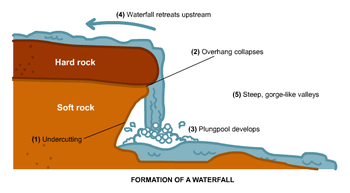This waterfall I discovered last year while geocaching in the
nearby area of Osceola. Had it not been for geocaching I may not
have discovered this location, since I have come to this area 1-2
times a year for about 15 years and had not discovered it
previously (we have relatives that live nearby).
A little about the falls:
Cascade Falls is located in the small village of Osceola along the
St. Croix River. It is a familiar story: the much larger St. Croix
has carved out a deep gorge into which the much smaller Osceola
Creek falls. A set of stairs located right off the main road into
Osceola leads you down into the gorge and to the base of the falls.
The trail continues to the shores of the St. Croix. The Osceola
Creek drops 100 feet between town and the river, but this is the
only big drop.
The falls were the reason for the founding of the village. They
once supported a mill, and a brewery. Some ruins of the old
industry remain above the falls.

About Waterfalls Formation:
Typically, a river flows over a large step in the rocks that may
have been formed by a fault line. As it increases its velocity at
the edge of the waterfall, it plucks material from the riverbed.
This causes the waterfall to carve deeper into the bed and to
recede upstream. Often over time, the waterfall will recede back to
form a canyon or gorge downstream as it recedes upstream, and it
will carve deeper into the ridge above it.
Often, the rock stratum just below the more resistant shelf will be
of a softer type, meaning that undercutting due to splashback will
occur here to form a shallow cave-like formation known as a rock
shelter or plunge pool under and behind the waterfall. Eventually,
the outcropping, more resistant cap rock will collapse under
pressure to add blocks of rock to the base of the waterfall. These
blocks of rock are then broken down into smaller boulders by
attrition as they collide with each other, and they also erode the
base of the waterfall by abrasion, creating a deep plunge pool or
gorge.
Streams become wider and shallower just above waterfalls due to
flowing over the rock shelf, and there is usually a deep pool just
below the waterfall because of the kinetic energy of the water
hitting the bottom. Waterfalls normally form in a rocky area due to
erosion.
Waterfalls can occur along the edge of glacial trough, whereby a
stream or river flowing into a glacier continues to flow into a
valley after the glacier has receded or melted. The large
waterfalls in Yosemite Valley are examples of this phenomenon.

Additionally Waterfalls are classified by home much water volume
is present, on a scale from 1-10. Niagara Falls would be an example
of a 10. Angel Falls, the Worlds Tallest Falls in Venezuela, is an
8. And Yosemite Falls is a 6. Cascade Falls obviously is classified
much lower.
There are also 10 types of waterfalls, the types are based on how
the water flows over the over hanging rock. Some examples include
Niagara Falls which is a Cataract Waterfall and Havasu Falls (near
Supai, AZ) is a Plunge Waterfall.
To log this cache I ask the following:
1) Take a picture of the falls with a member of your caching team
present or your GPS Unit (if solo caching).
2) What direction is the Osceola Creek flowing after it goes over
the falls?
3) Approximately what is the height of the falls?
4) What type of waterfall is Cascade Falls?
Please post the photo and email me the answers. Emails that do
not include all the answers will be deleted.
This location is equally pretty in winter and in summer, with two
completely different looks.
Posted coords will bring you to a staircase that will bring you
down to the falls, in winter they can be slick and not shoveled
